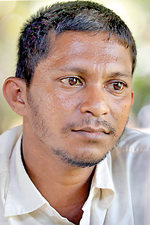Oil anointing: Fostering a collective consciousness

Oil anointing in the temple: An age-old ritual
Kalu kaputa sudu wenathuru (until the black crow turns white)
Garandiyaata an enathuru (until a serpent grows horns)
Molgase dalul enathuru (until leaves are sprung on a pestle)
Ekasiya wissata desiya wissak aawada aayubowewa (may you have a long life)
This is the blessing recited when the oil anointing traditional ritual is done following the dawn of the Sinhala and Tamil New Year. The above mentioned series of impossible transformations is used to give the blessing of long life to the anointed.The metaphors used in this recitation sometimes vary regionally, explains Assistant Lecturer from the Department of Sinhala, University of Colombo, Nalaka Jayasena.
Oiling one’s hair with coconut oil is a daily ritual for many Sri Lankans. The practice of anointing oil following the dawn of the new year though is special and distinctly different from this daily practice, Mr. Jayasena says.
Thel Ambul Koona Mangalyaya and Thel Avurudda (oil year) are early names for what we now call the oil anointing ceremony. Ceremonially anointing oil on one’s head following the dawn of the new year, is meant to bring good health throughout the year. In an agricultural society physical health was important as farmers needed strength to carry out their daily labours.
The oil made for anointing purposes is a combination of herbs (Naanu) that have special medicinal qualities.

Nalaka Jayasena
On the day of the ceremony the entire village gathers at the temple. This is a practice that fosters collective consciousness and is symbolic of a community journeying together. This ceremony has always received state sponsorship.To-date there is always a state sponsored oil anointing ceremony held at a leading temple in the country.
Sinhalese cultural practices are intertwined with Buddhism. In veneration, the head monk of the temple or a village chief anoints Naanu on a mirror reflection of a Buddha statue, which is similar to the traditional practice of drawing eyes of Buddha statues by only looking at the drawing’s mirror reflection. This is done before oil is anointed on people.
However most Avurudu practices have been limited to villages, which is why official records of Avurudu are not found until the Kandyan period, Mr. Jayasena says.
It was also the practice to anoint cattle as they played a significant role in agriculture. Although this practice has died out, elephants in temples are anointed with oil and blessed in appreciation of their service.
There is an auspicious direction towards which one must face during the ceremony and an auspicious time in which this ritual should be practised. Leaves that are considered auspicious are hung above the anointed’s head and laid below his or her feet. These leaves vary by the year and day of the week according to astrology. After the oil anointing it is customary, you look towards the auspicious direction and bathe.


